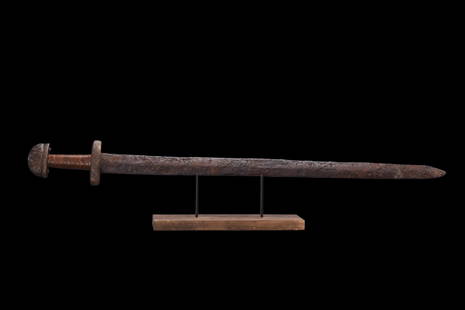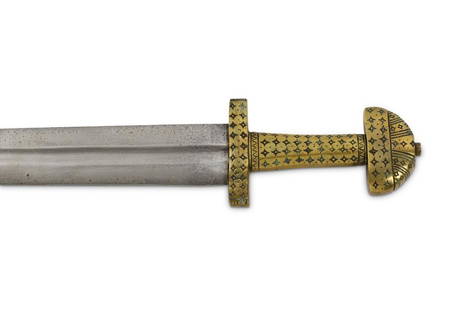
Tudor Era Hand-and-a-Half Sword
TUDOR Sale History
View Price Results for TUDOR

Related Weapons & Armor
More Items from TUDOR
View MoreRecommended Collectibles
View More


Item Details
Description
Mid 16th century AD. A German Renaissance 'hand and a half' or 'Bastard' sword, with ring guard, double-edged broad blade, lenticular in section, with single short shallow fuller, running up half of its length; complex hilt, with pommel (style T1) in shape of truncated wedge, closed by a rivet on the top, long tang, cross-guard widening towards the edges where the iron quillons are ending with a triangle; the handle presents a double-sided guard together with the knuckle bow; it shows two additional rings on the lower part of the hilt, bowing towards the flat blade, which is decorated with an unidentified maker’s mark, impressed just under the fuller. See Talhoffers Fechtbuch aus dem Jahre 1467, gerichtliche und andere zwei Kämpfe darstellend, ed. Hergsell G., Prag,1887; Dufty, A.R., European Swords and daggers in the Tower of London, London, 1974; Talhoffer, H., Medieval Combat: a Fifteenth-Century Illustrated Manual of Swordfighting and Close-Quarter Combat, by Rector, M. (ed.), London, 2000; Oakeshott, E.,Sword in hand, London, 2001; the sword is a good parallel with the sword kept in the Tower, published by Dufty (1974, pl.14, lett.a), clearly coming from the same workshop, as shown by the same mark impressed upon the blade (1974, pl.106, lett.9b"). 1.4 kg, 1.2m (47 1/4"). From an important private family collection of arms and armour; acquired on the European art market in the 1980s, and thence by descent; believed from Leige, Belgium; accompanied by an academic report by military specialist Dr Raffaele D'Amato. In the inventory of the Tower of London, in 1547 AD, Grete slaghe swordesie. two handers, are mentioned. Since the last quarter of the 15th century began the development of the hilt of the arming sword, which eventually become a rapier, paralleled by the big 'bastard' swords (Oakeshott, 2001, p.137"). Until 1500 AD, the two-handed sword was mainly relegated to use in duels, so much so that in 1409 AD Fiore dei Liberi published the first Italian manual on the use of this weapon, followed by Filippo Vadi some ten years later, who drafted also a series of points necessary to allow a sword to be defined as 'two-handed'. In the famous Talhoffers Fechtbuch are illustrated the various ways and movements of such combats with the double-handed sword: the first sixty seven plates are dedicated to the fight with the 'Langes Schwert' (longsword"). The fencing is analysed in all the various moments, by instructing regarding positions or guards until the guidance of real blows: at the beginning, further explaining the various engagements, as well as how the most varied movements with the blade and the handles should be done, and mentioning the various booklets about the sword. The fencing is analysed in detail. The author explains how to put focus on the key moments of the fight: how to hold the point of the blade and to rip with the quillons of the handle, how to make a blow with reversed sword or how to push with the sword pommel against the face of the opponent, or to complete the fight in appropriate moments by a wrestling match. Finally, without having incurred any damage, the author explains how to emerge victorious or disarm the opponent. With the arrival of the new century, the grip was made safer by altering at the handle and the base of the blade, which was lengthened until the sword reached the height of a man; moreover, the two-handed sword gained popularity in battle, where it was used to knock down the wall of enemy spades. The average weight of a two-handed sword was about one and a half kilograms, and the total length ranged from 110 to 150 cm. The 16th century was the peak of their popularity as weapons, Jacopo Gelli in his Guida del raccoglitore e dell’amatore di armiantiche (Guide for the collector and enthusiast of ancient weapons) defines such a weapon as 'Big Swiss Longsword', shaped like a biscia (whirlpool), used during the XVI century, to not be confused with the hand and half sword, having a snaked blade (from the French Flamboyante"). Italian sword makers referred always to such kind of blade as 'a biscia', imitating the shape of a creeping snake on the ground.
Condition
Fine condition. Rare.
Buyer's Premium
- 30%
Tudor Era Hand-and-a-Half Sword
Estimate £2,500 - £3,500
10 bidders are watching this item.
Shipping & Pickup Options
Item located in London, ukSee Policy for Shipping
Payment

TOP













































































![George Washington Signed Discharge: Partly printed discharge document signed by George Washington, as Commander in Chief of the Armies of the United States. Newburgh, [New York], 4 January 1783. 1 page, ## x ## in. Undersigned by Washin](https://p1.liveauctioneers.com/7226/322253/173251475_1_x.jpg?height=310&quality=70&version=1710004847)
![[Ambrotype] Texas Confederate Soldier: Sixth plate ambrotype. Full leatherette case. Portrait of a possible Texas Confederate soldier. A silver star device was used to pin up the brim of his light-toned headgear, a look often seen in image](https://p1.liveauctioneers.com/7226/322253/173251509_1_x.jpg?height=310&quality=70&version=1710004847)

